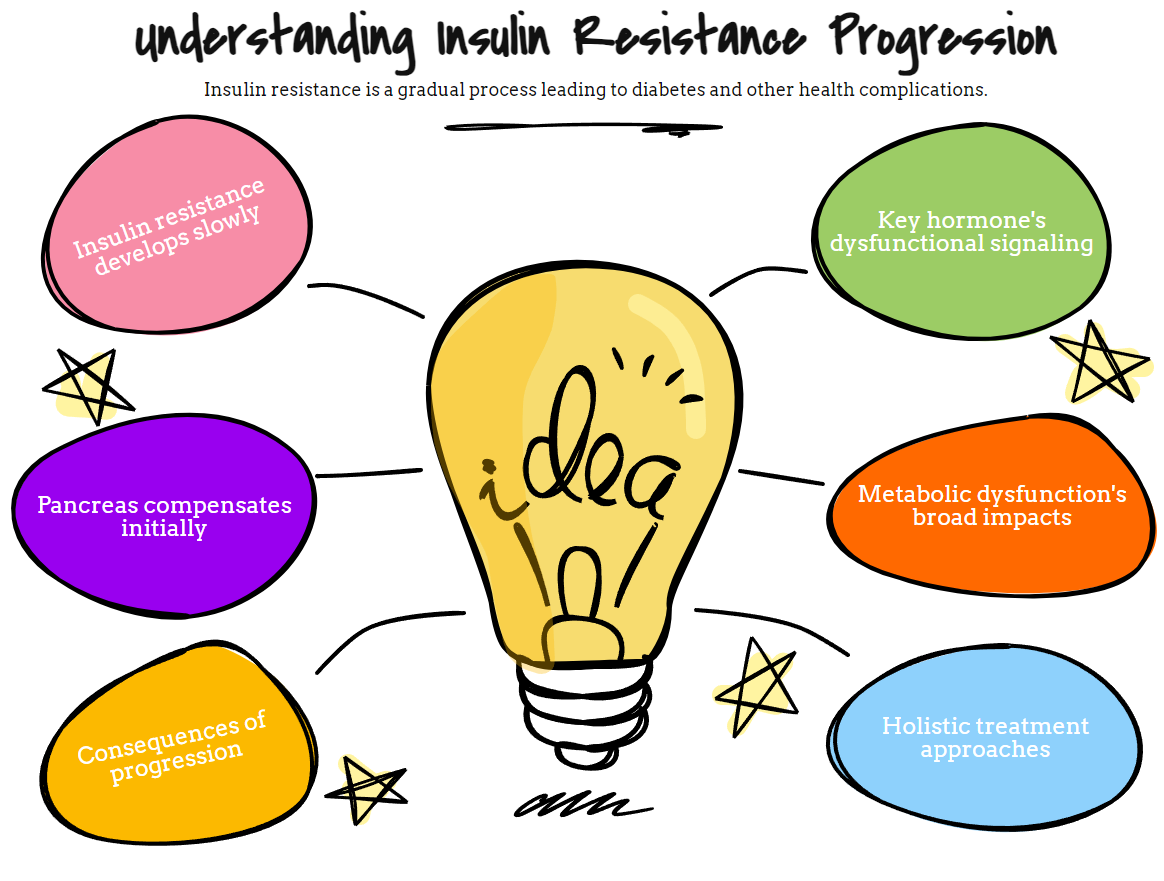
The Hidden Pathway From Insulin Resistance To Diabetes
The Hidden Pathway From Insulin Resistance To Diabetes
Your body speaks in whispers before it screams. The subtle signals of insulin resistance often go unnoticed for years while metabolic machinery slowly deteriorates. This invisible progression represents one of medicine's most critical windows for intervention, yet it remains poorly understood by patients and underappreciated by many clinicians.
Insulin resistance and diabetes exist on a continuum rather than as separate conditions. Understanding this progression reveals opportunities for earlier intervention and potentially reversing what many consider inevitable. The metabolic machinery connecting these states tells a fascinating story about how our bodies process energy, adapt to challenges, and eventually reach breaking points.
The Molecular Beginnings
At its core, insulin resistance starts when cells stop responding appropriately to insulin signals. This hormone acts like a key, unlocking cellular doors to allow glucose entry. When these locks become damaged through inflammation, excess fat accumulation, or other factors, the keys still exist but no longer work efficiently.
The pancreas compensates by producing more insulin. This hyperinsulinemia temporarily maintains normal blood glucose but creates a physiological burden. The beta cells of the pancreas work overtime, and tissues throughout the body experience the effects of abnormally high insulin levels, including increased fat storage, elevated blood pressure, and disrupted cholesterol metabolism.
Research now reveals this isn't simply about glucose. Insulin resistance disrupts multiple metabolic pathways simultaneously. Fat metabolism becomes dysregulated. Inflammatory signals increase. Mitochondria, our cellular power plants, function less efficiently. This creates a self-reinforcing cycle where each disruption worsens the others.
The Tipping Point
When compensatory mechanisms fail, the progression from insulin resistance to prediabetes and eventually type 2 diabetes occurs. The overworked pancreas reaches its limit. Beta cells begin to die off through processes called apoptosis and dedifferentiation. The remaining cells cannot produce enough insulin to overcome resistance.
Blood glucose levels rise after meals (postprandial hyperglycemia), and then fasting levels increase. The diagnostic thresholds we use—fasting glucose above 126 mg/dL or HbA1c above 6.5% for diabetes—represent arbitrary points on a continuous spectrum of metabolic dysfunction.
The timeline of this progression varies dramatically between individuals. Genetic factors, lifestyle choices, and environmental exposures influence how quickly someone moves from insulin resistance to diabetes. Some people remain in a compensated insulin-resistant state for decades without developing diabetes, while others progress rapidly within a few years.
Beyond Blood Sugar
The consequences of this progression extend far beyond glucose metabolism. Insulin resistance correlates strongly with cardiovascular disease risk even before diabetes develops. The same inflammatory processes that damage insulin signaling harm blood vessels, promote atherosclerosis, and increase clotting risk.
Fatty liver disease, polycystic ovary syndrome, sleep apnea, certain cancers, and neurodegenerative conditions all show associations with insulin resistance. This suggests the metabolic dysfunction represents a fundamental cellular problem affecting multiple organ systems rather than just a blood sugar issue.
Intervention Approaches
Treatment strategies differ depending on where someone falls on the insulin resistance spectrum. Early intervention focuses on lifestyle modifications, particularly physical activity and dietary changes. Exercise directly improves insulin sensitivity through multiple mechanisms, including muscle glucose uptake, mitochondrial function, and reduced inflammation.
Nutritional approaches show more controversy but generally emphasize reducing refined carbohydrates and processed foods while increasing fiber, protein, and healthy fats. Intermittent fasting and time-restricted eating show promise by allowing cellular repair processes to activate and reducing insulin levels.
Medications enter the picture at different stages. Metformin primarily reduces liver glucose production and often serves as first-line therapy. Newer agents like GLP-1 receptor agonists and SGLT2 inhibitors offer multiple benefits beyond glucose control, including weight reduction, cardiovascular protection, and kidney preservation.
The treatment paradigm has shifted from glucose-centric to addressing the broader metabolic dysfunction. This holistic approach recognizes that normalizing blood sugar alone fails to address the underlying pathology or prevent complications.
Rethinking Prevention
Understanding the continuum from insulin resistance to diabetes challenges our prevention models. Rather than waiting for prediabetes to intervene, identifying and addressing insulin resistance earlier could prevent significant metabolic damage.
Advanced testing beyond basic glucose measurements—including insulin levels, inflammatory markers, and detailed lipid profiles—may identify at-risk individuals decades before conventional diagnostics. Continuous glucose monitoring, even in nondiabetic individuals, reveals metabolic patterns invisible to traditional testing.
Population approaches must address the environmental drivers of insulin resistance - food systems promoting ultra-processed products, built environments discouraging physical activity, and socioeconomic factors limiting access to preventive resources.
The insulin resistance pandemic requires both individual and systemic solutions. Our intervention strategies must evolve accordingly as our understanding of the progression mechanisms improves. The goal shifts from managing end-stage disease to preserving metabolic health from the earliest possible moment.
The whispers of insulin resistance contain critical information. Learning to hear and interpret these signals represents our best chance at turning the tide against the diabetes epidemic. The biological machinery connecting these conditions gives us multiple intervention points - we need only the wisdom and will to use them effectively.
